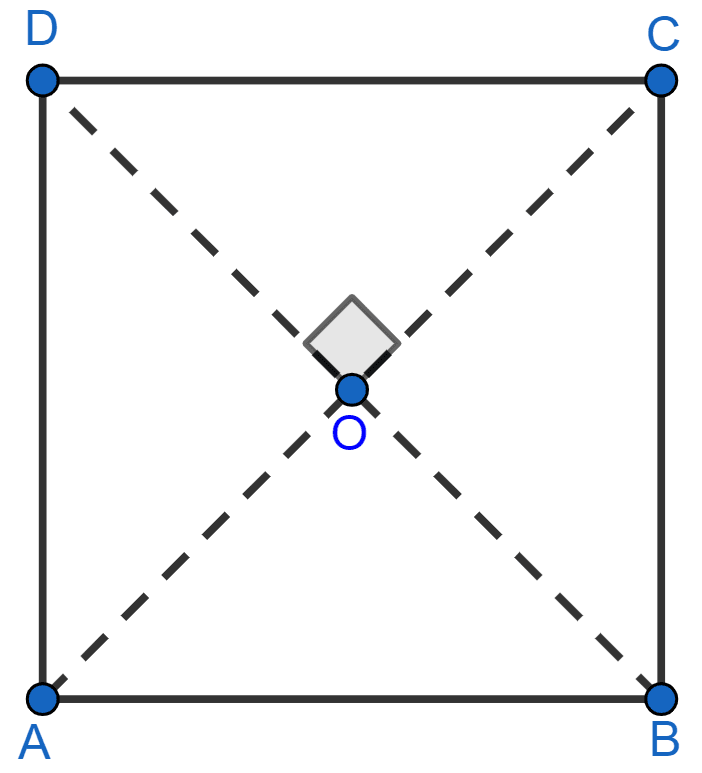Mathematics
Show that if the diagonals of a quadrilateral are equal and bisect each other at right angles, then it is a square.
Rectilinear Figures
9 Likes
Answer
Since, diagonals bisect each other at 90°
∴ ∠AOB = ∠COD = BOC = AOD = 90°.
From figure,

Considering △OAB and △ODC we have,
⇒ OA = OC (As diagonals bisect each other)
⇒ OB = OD (As diagonals bisect each other)
⇒ ∠AOB = ∠COD (Vertically opposite angles are equal)
Hence, △OAB ≅ △ODC by SAS axiom.
AB = CD (By C.P.C.T.) ………(i)
∴ ∠OAB = ∠OCD (By C.P.C.T.)
The above angles are alternate angles.
Hence, we can say that AB || CD.
In △AOB,
OA = OB (As both diagonals are equal and bisect each other)
so,
⇒ ∠OBA = ∠OAB = x (let) (Angles opposite to equal sides are equal in isosceles triangle)
⇒ ∠OBA + ∠OAB + ∠AOB = 180°
⇒ x + x + 90° = 180°
⇒ 2x = 180° - 90°
⇒ 2x = 90°
⇒ x =
⇒ x = 45°.
Considering △OAD and △OBC we have,
⇒ OA = OC (As diagonals bisect each other)
⇒ OB = OD (As diagonals bisect each other)
⇒ ∠AOD = ∠COB (Vertically opposite angles are equal)
Hence, △OAD ≅ △OBC by SAS axiom.
AD = BC (By C.P.C.T.) ………(ii)
∠OAD = ∠OCB (By C.P.C.T.)
Hence, we can say that AD || BC.
Considering △AOB and △AOD we have,
⇒ AO = AO (Common side)
⇒ OB = OD (As diagonals bisect each other)
⇒ ∠AOD = ∠AOB (Both equal to 90°)
Hence, △AOB ≅ △AOD by SAS axiom.
AB = AD (By C.P.C.T.) ………(iii)
From (i), (ii) and (iii) we get,
AB = BC = CD = AD.
In △AOD,
OA = OD (As both diagonals are equal and bisect each other)
so,
⇒ ∠OAD = ∠ODA = a (let) (Angles opposite to equal side are equal in isosceles triangle)
⇒ ∠OAD + ∠ODA + ∠AOD = 180°
⇒ a + a + 90° = 180°
⇒ 2a = 180° - 90°
⇒ 2a = 90°
⇒ a =
⇒ a = 45°.
∠A = ∠OAB + ∠OAD = 45° + 45° = 90°.
Thus, AB ⊥ AD.
Since, AD || BC so, AB ⊥ BC.
Since, AB || CD and AB ⊥ AD,
∴ CD ⊥ AD.
Since, alternate sides are perpendicular and all sides are equal.
Hence, proved that if the diagonals of a quadrilateral are equal and bisect each other at right angles, then it is a square
Answered By
7 Likes
Related Questions
If the diagonals of a quadrilateral are equal and bisect each other at right angles, then prove that it is a square.
If ABCD is a rectangle in which the diagonal BD bisects ∠B, then show that ABCD is a square.
P and Q are points on opposite sides AD and BC of a parallelogram ABCD such that PQ passes through the point of intersection O of its diagonals AC and BD. Show that PQ is bisected at O.
In figure (1) given below, ABCD is a parallelogram and X is mid-point of BC. The line AX produced meets DC produced at Q. The parallelogram ABPQ is completed. Prove that
(i) the triangles ABX and QCX are congruent.
(ii) DC = CQ = QP
